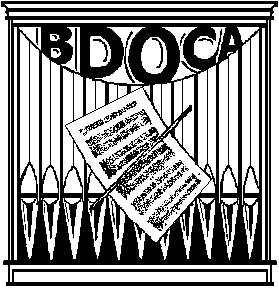
Bexley District
Organists' & Choirmasters' Association





A pipe organ is a musical instrument that produces sound by air vibrations created in an organ pipe, which is controlled by a musician from a keyboard. Since there is just one pipe for each note, a keyboard with 61 notes (5 octaves) would have 61 pipes, one for each note. The one set of pipes for each note on the keyboard makes just one kind of sound.
The organ will have several sets of pipes; each of these sets of pipes is called a “rank” which can make different sounds. This is similar to an orchestra which has many different types of instruments, each having its own characteristic sound. There are many more pipes in an organ than the ones you typically see.
Each rank of pipes is controlled by a “stop” which is pulled in or out to switch the air supply to the rank of pipes on or off. Organs can have usually between one and seven manuals. Most organs have between two and three with cathedral organs often having four or five.
To many people, the pedalboard is what characterises an organ and is a keyboard but played with the feet. The layout of it is the same as a manual keyboard (with 'white and black' notes). The largest pipes of the organ are included in the Pedal Organ. In such things as hymns and anthems the pedals play the bass part, in dedicated organ music their involvement can be more (frighteningly) complex. In the UK pedalboards can be 'straight' or radiating and concave.
The organ pipes sit on a box called the Soundboard or Wind Chest. Each Manual usually has its own Soundboard. There are different methods of letting air into the pipes to make a sound. The oldest and most direct is a mechanical rod from the key to the valve (pallet) which sits under the pipe to let air into the pipe. This is called tracker action. The next most common action is pneumatic action The operation of a tubular-pneumatic organ is accomplished by a change of air pressure within lead tubes of about 1⁄4 in (0.6 cm) inside diameter that connect the organ's console to its windchest. A separate tube is needed for each manual key, pedal key and stop control on the console.
Two basic types of tubular-pneumatic actions were used: the "pressure" system and the more popular "exhaust" system. Both use three major components for each key and stop: a valve (within the console), a pneumatic motor (valve within the windchest), and a lead tube that connects them.
In the pressure system, the air in the tube and the pneumatic motor are normally at atmospheric pressure. Depressing a key increases the pressure in the tube, inflating the pneumatic motor, which opens the pipe's valve.
In the exhaust system, the pneumatic motor and tube normally contain windchest pressure. Depressing a key lets this pressure exhaust, which collapses the pneumatic motor and opens the pipe's valve.
Organ Pipes: Two main types: 1) Flue pipes: these could be thought of as lots of different sizes of quite sophisticated whistles; 2) Reed pipes, the sound is produced by a vibrating reed, similar to the way a clarinet or saxophone produces sound. (Shown in red on the Stop List above) Pipes have moods according to the weather, i.e. humidity, temperature, air pressure etc. The sound and the tuning can be quite different on some days or when the church heating is on in the same way as a choir's sound and tuning varies. It's not easy to simulate these subtle changes by electronic means, electronic organs sound the same every day. Organ pipes have feet, mouths, ears, tongues, even beards. Every pipe is different and pipe making is a highly skilled job (making one rank of pipes can take a pipe maker around a month's work) but when the pipe maker has finished his job they do not make a sound, or 'speak'. The pipe voicer sets their speech. If he is good at his art he makes them 'sing'.
Numerical designations such as 8', 4', 2', 16' etc. show the length of the longest pipe in the stop. If middle C on the stop sounds at the same pitch as Middle C on the piano the longest pipe is 8 feet long, if it is an octave higher the longest pipe is 4', an octave lower is 16 feet and so on. Some 'mutation' stops and Mixture stops do not sound at the normal pitch, they sound some notes higher so the longest pipe is a weird length, such as 1 3/5'. Just to complicate matters, if you put a stopper in the top of a pipe it sounds an octave lower.